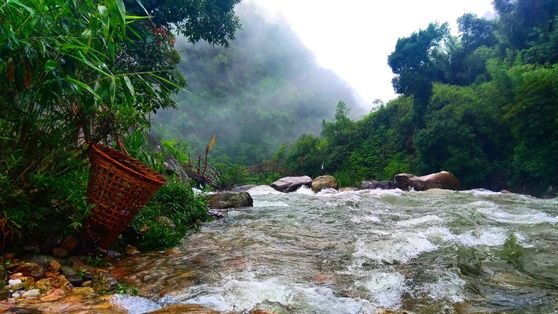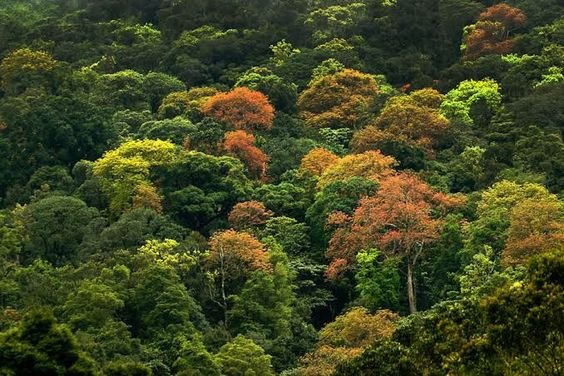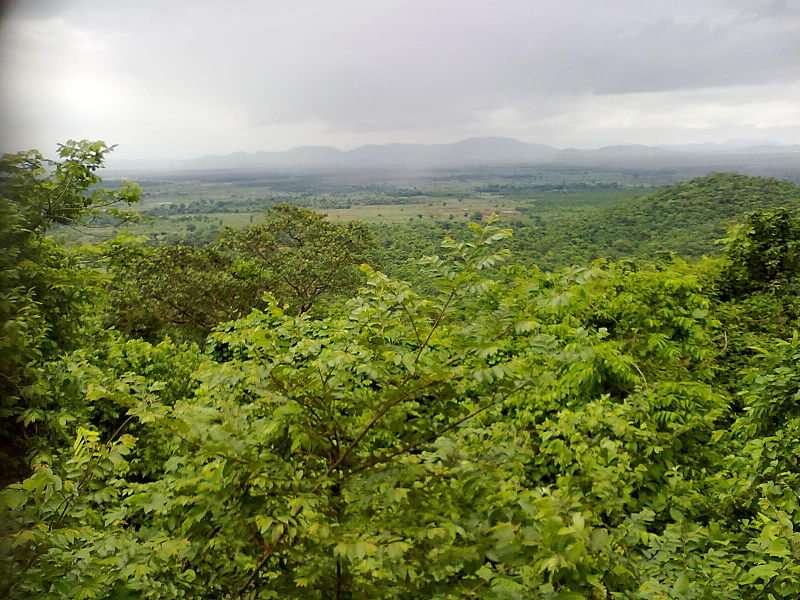A rainforest is an area of tall, mostly evergreen trees and high rainfall. Rainforests are Earth’s oldest living ecosystems, with some surviving in their present form for at least 70 million years. The Amazon is the World’s largest rainforest. Here I am going to mention 4 major mesmerizing Rainforests in India, which are full of the finest flora and fauna. Fortunately, India is home to these enchanting beauties that help maintain the sanity of nature.
- Andaman & Nicobar Tropical Rainforests
- Northeastern Rainforests
- Western Ghats Rainforests
- Odisha Semi-evergreen Rainforest
1. Andaman & Nicobar Tropical Rainforests-

The Union territory is home to some beautiful tropical evergreen rainforests, tropical semi-evergreen forests, and tropical monsoon forests, which protect around 84.4 percent of the Andaman Islands.
Average Annual Rainfall-
Annual rainfall is around 3,000-3,800 mm and falls mostly during the monsoons.
Biodiversity-
The large variety of flora and fauna makes this place more special. The tropical forest canopy of this region has a mixed range coming from India, Myanmar, Malaysia, and endemic flora. There are several species of Keruing wood, with Dipterocarpus grandifloras being dominant in hilly regions, and Dipterocarpus kerrii dominating some islands in the southern parts of the archipelago.
The Andaman Islands are a wildlife hotspot because they are home to at least two kinds of wild boars, feral elephants, four species of sea turtles, and wild saltwater crocodiles. With at least 240 different bird species present, the Andaman Islands are a popular location for birdwatching. Here, you may see Andaman wood pigeons, the state bird of the archipelago.
Nearby Attractions-
- Chidiyatapu Sunset Point
- White Surf Waterfall
- Path To Elephant Beach Walking
- Mangrove Forest
- Kalpong River Waterfall
- Mahatma Gnadhi National Park
Best Time to Visit- November to February
Best Places to stay during your visit-
- Jungle Villa Resort & Spa
- SilverSand Village Resort Havelock
- Sea Hills Hotels & Resorts
- SeaShell, Havelock
- Barefoot at Havelock
- Symphony Summer Sands
2. North-Eastern Rainforests-

The Assam region in northeast India is home to some of India’s most remote, dense, and untouched rainforests. Although Northern Assam has most of the forests, Nagaland, Manipur, Mizoram, and Tripura also have some of them. Most of this region is at an altitude of around 900 meters.
Average Annual Rainfall-
Annual rainfall is around 1500-3750 mm mostly during the monsoons of the year.
Biodiversity-
Rhesus macaques, Pig-tailed macaques, Assamese macaques, Slow Loris crested Langurs, Wild Elephants, Stam-tailed macaques, and Hoolock Gibbons, Orchids, Ferns, Oaks, Magnolias are a few of the most well-known plant and animal species found in the area. The Joydihing wildlife sanctuary, located in Upper Assam, consists of the Joypur Reserve Forest, Dirak Reserve Forest, and Dihing Reserve Forest.
Nearby Attractions-
- Kazhiranga National Park
- Kamakhya Temple
- Purva Tirupati Shri Balaji Temple
- Kakochang Waterfalls
- Brahmaputra River
- Nathula Pass, Sikkim
- Tsomgo Lake, Sikkim
- Tawang Monastery, Arunachal Pradesh
- North Cachar Hills
Best Time to Visit- October to April
Best Places to stay during your visit-
- Brahmaputra Jungle Resort
- Kanoka Village Resort
- Musa Jungle Retreat
- Ratnamouli Palace
- Orang Village Resort
- Mayfair Guwahati
3. Western Ghats Rainforests-

Tropical Rainforests in the Western Ghats, which start in Southwest Maharashtra and stretch up to Karnataka in South India, are renowned to be one of the thickest, covering a total area of 30000 square kilometers. The forest is home to about 1100 different types of animals, with elephants making up most of the woodland’s wildlife. Due to urbanization and commercialization, these forests are depleting.
Average Annual Rainfall-
Annual rainfall is around 3000-4000 mm mostly during the monsoons of the year.
Biodiversity-
The Western Ghat forest region is renowned for housing Asia’s greatest elephant population. The Western Ghats are home to 229 plant species, 31 animal species, 15 bird species, 43 amphibian species, 5 reptile species, and 1 fish species, all of which are internationally threatened. Lion-tailed macaques, Indian spotted chevrotains, Great hornbills, Gray slender lorises, and King cobras inhabit this area.
Nearby Attractions-
- Munnar
- Dandeli
- Coorg
- Mollem National Park
- Coonoor
- Idukki
- Mahabaleshwar
Best Time to Visit- September to March
Best Places to stay during your visit-
- Hotel White House Munnar
- Talayar Valley Bungalow
- Hut Holidays Inn Munnar
- Lumino Dwellings
- Kurinji Wanderlust Munnar
4. Odisha Semi-evergreen Rainforest-

The Odisha semi-evergreen forests (also known as Orissa semi-evergreen forests) are an eastern Indian tropical wet broadleaf forest ecoregion. The ecoregion, which transitions from the vast ecoregion Lower Gangetic Plains moist deciduous forests along the north coastland to the smaller ecoregion Godavari-Krishna mangroves along a stretch of the south-east coast by the Bay of Bengal, covers an area of 8,600 square kilometres (3,300 sq mi) on the coastal plain of Odisha state. It is bordered by the Eastern Highlands moist deciduous forests in the west and north-west.
This ecoregion is home to many of Odisha’s biggest cities, including Bhubaneswar, Cuttack, Puri, Chhatrapur, Kendrapara, and Bhadrak. It has been extensively cleared for farming and urban development. Only 4% of the ecoregion’s land is still covered in the original semi-evergreen rain forest, according to the WWF, which claims that 96% of the territory has been removed. By cutting down on fuelwood and grazing, the remaining forest has been severely damaged.
Biodiversity-
Though there are no endemic species in this ecoregion, several large mammals, including elephants and tigers, are still living here in spite of the heavy anthropogenic changes of the landscape. The tiger, Asian elephant, gaur, dhole (cuon alpinus), sloth bear, and chousingha (tetracerus quadricornis) are among the mammals that require special attention.
These forests typically include Artocarpus, Michelia, Bridelia, Ficus, and Mangifera trees. The last two are figs and mangoes respectively. Among the dense forests, there are patches of canebrakes and bamboo brakes.
Nearby Attractions-
- Mangalajodi
- Bhitarkanika Wildlife Sanctuary
- Debrigarh Wildlife Sanctuary
- Tamparalake
- Chilika Wildlife Sanctuary
- Satkosia Garge Wildlife Sanctuary
- Balukhand Wildlife Sanctuary
- Daringbadi
- Kuldiha Wildlife Sanctuary
- Similipal Tiger Reserve
Best Time to Visit- October
Best Places to stay during your visit-
- Satkosia Hill View Resort
- Lulung Aranyanivas
- Tampara Resort
- Regenta Inn Sambalpur
- Swosti Chilika Resort
- Panacea Eco Resort
- Sand Pebbles Bhitarkanika Jungle Resorts
By discovering these enchanting rainforests in India, travelers will create lots of adventurous memories full of wildlife and nature. The rainforests are a natural treasure that must be protected and preserved.
You May also Like: Sitala Sasthi- The First Love Marriage In Hindu Culture